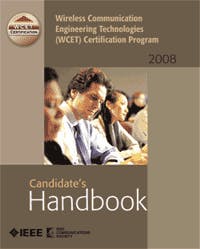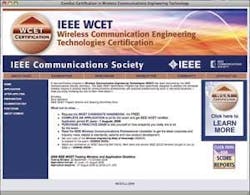Program seeks to address the growing need for wireless professionals who have quantifiable, real-world problem-solving skills.
This fall, the IEEE Communications Society (ComSoc), the leading worldwide professional organization dedicated to the advancement of communications technologies, will hold the first-ever testing period for its newly-launched Wireless Communication Engineering Technologies (IEEE WCET) Certification Program.
From September 22 through October 10, engineers and communications professionals from around the world are expected to test their practical knowledge of wireless technologies at more than 500 testing sites located in 75 countries. In the future, IEEE ComSoc expects to renew this effort semi-annually, with the next testing cycle scheduled for March to April 2009.
Introduced earlier this year, the IEEE WCET program was developed by IEEE ComSoc and an international collection of industry experts to address the worldwide wireless industry's growing need for professionals with real-world problem-solving skills. The certification was also specifically designed to provide professionals with a quantifiable method for demonstrating their expertise in the wireless field as new opportunities develop throughout the world.
To qualify for the IEEE WCET designation, candidates with a bachelor's or comparable degree from an accredited institution and at least three years of professional wireless engineering experience must pass the program's detailed comprehensive examination developed by leading industry experts and experienced wireless practitioners. Administered on computer at selected worldwide locations, the official IEEE WCET examination is composed of 150 multiple-choice questions. Each applicant is given up to four hours to complete the exam.
The $500 fee ($450 for IEEE and ComSoc members) covers the application, processing, "seat fee", scoring and reporting, and a certificate sent to those who pass the exam.
Career advancement, and more
"This is a very practical program that will help wireless professionals advance in their field, develop new opportunities in a global marketplace, and certify their knowledge as it is used with real-world applications," says Celia Desmond, IEEE WCET program director. "The certification will also help individuals working in other engineering areas switch to the wireless field as new and exciting job oppor- tunities arise."
According to Rolf Frantz, the program's industry relations manager and a communications industry veteran, "The exam itself is vendor-neutral and transnational in scope, and will provide employers with a valid tool for measuring an individual's ability to meet wireless challenges in numerous industry, business, corporate and organiza- tional settings. With this certification, professionals will be able to clearly demonstrate their knowledge of wireless communications technologies to employers, or to change engineering fields as new opportunities arise in the industry."
The process of developing the IEEE WCET program began with a market assessment conducted by the Holmes Corp. (www.holmescorp.com), renowned for partnering with associations to develop first-rate educational products and programs. According to the Holmes study, which was commissioned by IEEE ComSoc in 2006, positions within the wireless industry are expected to increase throughout the world by 10 to 36% by 2014. This growth is also predicted to open new wireless opportunities for nearly 450,000 professionals in the United States alone, as well as thousands of other wireless communications jobs requiring technical expertise in markets located throughout the world.
Based on these results, as well as similar assessments and insights from numerous wireless communications experts worldwide, IEEE ComSoc devised and then initiated a series of best credentialing industry practices to launch the IEEE WCET program under the guidance of Professional Examination Service (PES), a renowned professional credential developer with a 60-year history of creating, implementing, and enhancing quality programs.
Among these efforts was the organization of a Practice Analysis Task Force (PATF) that included 16 wireless industry experts from Australia, Egypt, India, Japan, Malaysia, the United States, and Uruguay. With their combined knowledge of the wireless industry, the PATF developed a draft Delineation highlighting the technical areas of responsibility, tasks, and knowledge that might be expected of engineering practitioners seeking WCET certification.
One method used by the PATF to gather additional information from wireless communications experts worldwide was the coordination of focus groups held in conjunction with several major wireless conferences and IEEE meetings. In all, more than 10 focus groups were held in such countries as Bulgaria, China, Malaysia, Peru, Spain, and the U.S. In sessions that lasted two hours and longer, focus group participants, consisting of experienced wireless practitioners, discussed the content of the draft Delineation, and shared detailed suggestions on its overall structure and focus.
Another valuable resource was feedback provided by a group of independent reviewers comprised of more than a dozen experienced wireless industry professionals. Each of these volunteers spent numerous hours reviewing the Delineation and providing detailed input—in some cases, line by line—on the technical areas and the individual task and knowledge statements.
Worldwide support
Based on these suggestions and new expert input, the PATF reconvened in May 2007 to revise the Delineation and then develop a comprehensive practice analysis survey to validate the structure and content of the program's revised scope and content. More than 1,300 wireless professionals around the globe used the link to the online survey. It provided input about the importance of various wireless tasks and knowledge items, their practical uses within the industry, and the level of experience that should be expected from professionals who might perform the tasks in these areas.
To ensure continued industry input, the IEEE WCET program also established an Industry Advisory Board, comprised of senior representatives of wireless engineering technology companies. On an ongoing basis, these industry leaders are expected to guide the evolution of the program and champion its benefits within the industry, their companies, the IEEE, and other key professional wireless organizations.
As for the design of the exam itself, approximately 30 volunteers produced 600 examination questions tied to specific task or knowledge statements in the Delineation, which were than verified by readily available reference sources. From these questions, the official IEEE WCET examination was developed, consisting of 150 multiple-choice questions encompassing the wireless areas of RF engineering, propagation, and antennas; access technologies; network and service architectures; network management and security; facilities infrastructure; agreements, standards, policies, and regulations; and fundamental knowledge.
To aid candidates preparing for the exam, IEEE ComSoc also worked with its various IEEE WCET committees and PES to create a series of ongoing resources. These include a web site (www.iee-wcet.org) specifically dedicated to providing detailed information, ongoing updates, and free online re-sources highlighting the WCET program. The site also offers details on eligibility requirements, testing dates and locations, application information (including deadlines), examination specifications, links to training organizations, and free >resources, such as a glossary, a list of references, and sample questions for helping candidates thoroughly prepare for the exam.
Another prominent feature of the web site is access to a 75-question practice examination that offers communications professionals the opportunity to gauge their preparedness for the official IEEE WCET exam. Each practice examination consists of questions reviewed by WCET subject-matter experts, and was developed with the same methodology used to prepare the certification exam. For a one-time fee of $75, the practice examination can be taken up to four times before sitting for the official IEEE WCET exam. Test results are provided both as an overall score and by reporting the number of items answered correctly within each of the seven technical areas of expertise.
Resources and aids
Other resources designed to support the IEEE WCET program include free subscriptions to the bi-monthly IEEE Wireless Communications Professional electronic newsletter and a free Candidate's Handbook covering policies, subject area details, reference sources, and sample questions. Also recently introduced is the Wireless Engineering Body of Knowledge (WEBOK) book, which outlines the scope of wireless technologies and cites numerous wireless communication reference sources. Available in pdf and hard-copy for $45, the WEBOK includes seven chapters, each of which surveys a specific technical area of the Delineation and includes detailed references on the subject matter covered. A draft of the WEBOK is available free to anyone who takes the practice exam or applies for the full examination.
"The initial launch of the IEEE WCET program was greeted with a great deal of excitement and interest from IEEE global members, corporations worldwide, media, and thousands of wireless communications professionals," says Desmond. "We believe this program will provide a boon to the wireless industry, which is continually seeking new talent on a global scale, as well as to communications professionals looking to qualify their skills and take advantage of the latest array of wireless opportunities."
For more information, contact: Jean Niblett, IEEE Communications Society, 3 Park Ave., New York, NY 10016; (212) 705-8913; [email protected]; or, visit www.ieee-wcet.org
IEEE COMMUNICATIONS SOCIETY (www.comsoc.org) members who contributed to this article include: Celia Desmond, IEEE WCET program director; and Rolf Frantz, WCET industry relations manager. The IEEE Communications Society has more than 40,000 members and is the second largest of IEEE's 37 technical societies. Founded in 1952, it has become the major international forum for the exchange of ideas on communications and information networking.


